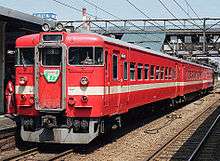Kamui (train)
The Kamui (カムイ) (named Super Kamui (スーパーカムイ) between 2007 and 2017) is a limited express train service operated by Hokkaido Railway Company (JR Hokkaido) since 2007 on the Hakodate Main Line, connecting Sapporo and Asahikawa in Hokkaido, Japan.[1]
A 789-1000 series EMU on a Super Kamui / Airport service in January 2009 | |
| Overview | |
|---|---|
| Service type | Limited express |
| Locale | Hokkaido |
| First service | 22 September 1959 (Kamui) 1 October 2007 (Super Kamui) 4 March 2017 (Kamui) |
| Current operator(s) | JR Hokkaido |
| Former operator(s) | JNR |
| Route | |
| Start | Sapporo |
| End | Asahikawa |
| Distance travelled | 136.8 km (85.0 mi) |
| Average journey time | 1 hour 20 minutes |
| Service frequency | Half-hourly |
| On-board services | |
| Class(es) | Standard class only |
| Technical | |
| Rolling stock | 789-1000 series EMUs |
| Track gauge | 1,067 mm (3 ft 6 in) |
| Electrification | 20 kV AC overhead |
| Operating speed | 130 km/h (80 mph) |
Service pattern
Services run every 30 minutes, with a journey time of 1 hour and 20 minutes for the 136.8 km (85.0 mi) between Sapporo and Asahikawa, giving an average start-to-stop speed of 102.6 km/h (63.8 mph).[2] Services departing from Asahikawa on the hour continue onward from Sapporo to New Chitose Airport as the Airport rapid service.[1]
Services stop at the following stations.
Rolling stock

Services are formed of five-car 789-1000 series EMUs. All seats are non-reserved, except for car 4, which has upgraded "u-Seat" accommodation, including AC outlets for personal use.[1][3]
- 785 series non-reserved seating, May 2008
- 785 series reserved "u-Seat" car, August 2007
- 789-1000 series non-reserved seating, May 2008
 789-1000 series reserved "u-Seat" car, September 2007
789-1000 series reserved "u-Seat" car, September 2007
Formations
The Kamui is operated by 5-car 789 series EMUs, formed as shown below, with car 1 at the Asahikawa end.[1][3][4] There are no "Green cars" in all departures, and all cars are no-smoking.
| Car No. | 1 | 2 | 3 | 4 | 5 |
|---|---|---|---|---|---|
| Accommodation | Non-reserved | Non-reserved | Non-reserved | Reserved (u-Seat) | Non-reserved |
| Facilities | Toilet | Wheelchair space, toilet | Toilet |
History
Kamui (1959 – 1988)

The original Kamui service started on 22 September 1959, as a "semi express" service operating between Otaru and Asahikawa.[5] From 1961, KiHa 56 express diesel multiple unit trains were introduced, and Kamui services were formally upgraded to "express" status from the start of the revised timetable on 5 March 1966.[5] Following electrification of the route, 711 series three-car EMUs were introduced on the Kamui 3 and 4 services from October 1968.[5] From 1 October 1969, these were increased to six-car formations.[6]
Typical 711 series EMU Kamui express formations were formed as shown below as of 1 October 1969, with car 1 at the Asahikawa end.[6]
| Car No. | 1 | 2 | 3 | 4 | 5 | 6 |
|---|---|---|---|---|---|---|
| Numbering | KuHa 711 | MoHa 711 | KuHa 711 | KuHa 711 | MoHa 711 | KuHa 711 |
From 15 March 1972, the number of Kamui services was increased from seven return workings to ten return workings daily.[6]
Kamui services were discontinued from 13 March 1988, when they were integrated with Sorachi express services.[7]
Super Kamui (2007 – 2017)
The Super Kamui service commenced on 1 October 2007.[8] Prior to this, two limited express trains, the Lilac and the Super White Arrow, ran on the same route between Sapporo and Asahikawa. These were integrated and remodeled into one service at the same time as the ageing 781 series EMUs previously used on Lilac services were withdrawn.[1]
Accidents
On 29 January 2010, the Super Kamui 24 service from Asahikawa to Sapporo was derailed after hitting a truck at a level crossing on the Hakodate Main Line between Fukagawa and Moseushi.[10] 23 passengers, the train driver, and the truck driver sustained minor injuries.[10] The five-car 789-1000 series set involved, HL-1005, was taken out of service due to damage, and was officially withdrawn on 24 March 2011.[11]
References
- JR新幹線&特急列車ファイル [JR Shinkansen & Limited Express Train File]. Japan: Kōtsū Shimbun. 2008. p. 84. ISBN 978-4-330-00608-6.
- Kekke, Yoshiyuki (August 2013). JR高速在来線列車ガイド [JR high-speed conventional train service guide]. Tetsudō Daiya Jōhō Magazine (in Japanese). Vol. 42 no. 352. Japan: Kōtsū Shimbun. p. 16.
- JR Timetable, August 2011 issue, p. 1002
- JR電車編成表 2012冬 [JR EMU Formations - Winter 2012]. Japan: JRR. October 2011. pp. 2–3. ISBN 978-4-330-25611-5.
- Teramoto, Mitsuteru (July 2001). 国鉄・JR列車名大辞典 [JNR & JR Train Name Encyclopedia]. Tokyo, Japan: Chuoshoin Publishing Co., Ltd. pp. 171–172. ISBN 4-88732-093-0.
- Miyake, Toshihiko (August 2012). 札幌周辺における国鉄・JRの電化と列車の変遷 [JNR and JR electrification and train changes in the Sapporo area]. Tetsudō Daiya Jōhō Magazine. Vol. 41 no. 340. Japan: Kōtsū Shimbun. pp. 24–33.
- 列車名鑑1995 [Train Name Directory 1995]. Japan: Railway Journal. August 1995. p. 124.
- Haraguchi, Takayuki (2009). Encyclopedia of JR's Railway Cars: JR全車輌. Japan: Sekai Bunka. p. 53. ISBN 978-4-418-09905-4.
- 平成29年3月ダイヤ改正について [March 2017 timetable revision] (PDF). News release (in Japanese). Japan: Hokkaido Railway Company. 16 December 2016. p. 3. Archived (PDF) from the original on 16 December 2016. Retrieved 17 December 2016.
- 列車事故:特急とトラック衝突 乗客ら25人軽傷 北海道 [Train accident: Hokkaido limited express collides with truck 25 passengers hurt]. Mainichi jp (in Japanese). Japan: The Mainichi Newspapers. 29 January 2010. Archived from the original on 2 February 2010. Retrieved 23 May 2012.
- JR特急電車編成表 1987~2012 [JR Limited Express EMU Formations - 1987-2012]. Japan: JRR. February 2012. p. 70. ISBN 978-4-330-27012-8.
External links
| Wikimedia Commons has media related to Kamui. |
- JR Hokkaido 789 series Kamui (in Japanese)